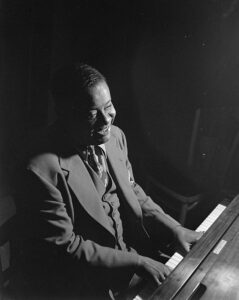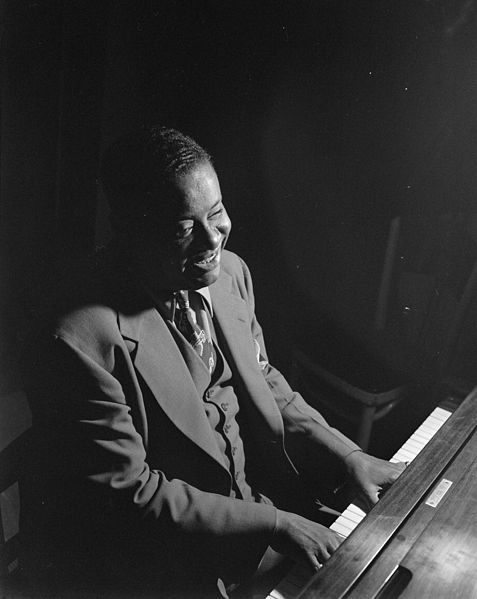
The Beginner’s Guide To Art Tatum
by
Ron Drotos
Art Tatum was one of the greatest pianists who ever lived. He’s also one of the most difficult to listen to when you first hear him play. In fact, it’s taken me decades to get to the point where I can follow along with him and appreciate what he’s doing, in real time, as he plays a jazz piece. This Beginner’s Guide To Art Tatum will give you a good overview of Tatum as a pianist and his place in the jazz world.
The first thing most people notice when hearing Tatum for the first time is the sheer magnitude of his technique. He plays fast! Yes, he plays the notes fast, but he also fits many ideas into each measure, going from one chord or phrase to another very quickly. It can initially be very overwhelming and a little disconcerting.
The second thing most jazz pianists do is to compare themselves to Tatum and think “Oh, I’ll never be able to do that!” If you’ve ever felt this about Tatum, it’s OK. You’re not alone! Many of the great pianists of the 30s and 40s got discouraged and temporarily quit playing piano for at least a few weeks after encountering Tatum’s playing. (This includes the great pianist Oscar Peterson!)
Art Tatum was born in Todelo, Ohio in 1909. To put this in context, it means that he was 8 years old when the first jazz recordings were made. He became almost entirely blind at an early age yet studied the classical piano repertoire despite this challenge. He brought a classically-influenced virtuosity to his jazz playing that far surpassed even the best of his peers.
Let’s start by listening to Tatum’s early recording of “Tiger Rag,” from 1933. Even though this was a commonly-played tune of the time, not many pianists were prepared for what they heard. Hold on to your seat belt!
More than one famous jazz pianist has said that they thought that there were two pianists playing on this recording. They couldn’t believe that one person could play all that with just 2 hands!
Once Tatum became established as a professional musician, he put together a piano-guitar-bass trio. This combination influenced later groups such as the Nat Cole Trio. Her’s Tatum’s group performing a pop song of the day, “On The Sunny Side Of The Street.
It seems to me that Tatum used the trio as a way to make his music more palatable to the general public. His playing with the trio was less dense than his solo style and the group generally played simpler arrangements than Tatum would have played while “on his own.”
Fortunately for us, Tatum was one of the most widely recorded artists in jazz history. This is in large part due to the producer Norman Granz, who frequently brought Tatum into the recording studio for his series of recordings called Solo Masterpieces and Group Masterpieces. Many horn players found it challenging to solo over Tatum’s accompaniment, which tended to be “busy,” to say the least! To my ears, he was sometimes going for a type of melodic interplay that recalls the earlier New Orleans polyphonic tradition.
I was lucky enough to study with the great jazz pianist Billy Taylor, who had known Tatum very well. I once remarked to Billy that I didn’t think Tatum was a very good accompanist. Taylor replied, “Well, he could when he wanted to be. Listen to the record he made with Ben Webster.”
I’ll pass that along to you here:
Art Tatum and Ben Webster: All The Things You Are
Even though Tatum was widely recorded, there are only a couple of video clips of him. Here he is, playing Jerome Kern’s song “Yesterdays” on television, which is the only complete song he played on video. I think I’ve watched this clip about a hundred times!
Yesterdays
For all his technique, one of the best aspects of Tatum’s playing is his swing feel, particularly when he played in a relaxed, medium swing groove. Here he is, playing one of his favorite songs, “Sweet Lorraine,” which he recorded 21 times in all.
To round out this survey of Art Tatum’s music, I’d like to include two more pieces. The first is W.C. Handy’s composition “Aunt Hagar’s Blues,” from Tatum’s 1949 recording. To me, this performance includes the entire history of jazz, even that which came much later!
Let’s finish up with some pianistic fireworks.
Just when you don’t think he can play any faster, Tatum turns the heat even higher at 1:49. Unbelievable!!!
Tatum died in 1956, at a time when the newer sounds of bebop and post-bop had made his music sound a little old-fachioned to many young jazz musicians of the time. Saxophonist Sonny Rollins remembers hearing Tatum’s group alternate sets with bebopper Charlie Parker one evening, and he says that he was more interested in hearing Parker at the time. It wasn’t until later that he realized how much he could learn from Tatum harmonically and in terms of what was possible to do with standard popular songs. The he bacame, in his own words, “a Tatum fanatic.”
Here’s where you can learn more about the great Art Tatum:
Wikipedia
https://en.wikipedia.org/wiki/Art_Tatum
Transcriptions
Here’s a video in which the pianist Ray Charles and filmmaker Clint Eastwood discuss Tatum and his music:
Check out this excellent interview where clarinetist Buddy DeFranco describes in detail what it was like to record an album with Tatum:
http://www.jazzwax.com/2009/04/interview-buddy-defranco-on-tatum.html
A short radio interview with Tatum:
Take your left hand playing to a new level with my free ebook: Left Hand Techniques for Jazz Piano
You’ll also get my weekly jazz newsletter with practice tips and inspiration

